Last Updated on 06/29/2021 by Veronica Jones
Sarcoptes Scabies in Dog ( Sarcoptes Scabiei var Canis) is a disease caused by Sarcoptes Canis parasitize under the epidermis of the skin. The disease causes atopic dermatitis nodules, a chronic progression accompanied by itchy, uncomfortable symptoms, and hair loss.
Disease characteristics
The cause of Sarcoptes Scabies in Dog is scabies Sarcoptes Canis parasites below the epidermis layer of the skin. This type of scabies belongs to the Sarcoptifomes group.
Scabies enters the epidermis, dig into the groove, take the lymph fluid and cell fluids of the host animals as nutrients. Adult male and female scabies mate in the groove. After mating, male scabies dies, the female digs a furrow in the epidermis to lay eggs;
Since there are backward spikes on the back, scabies will not move back and always move forward. On the groove of scabies, there have black spots of its feces and eggs at different stages of development that lay on this groove.
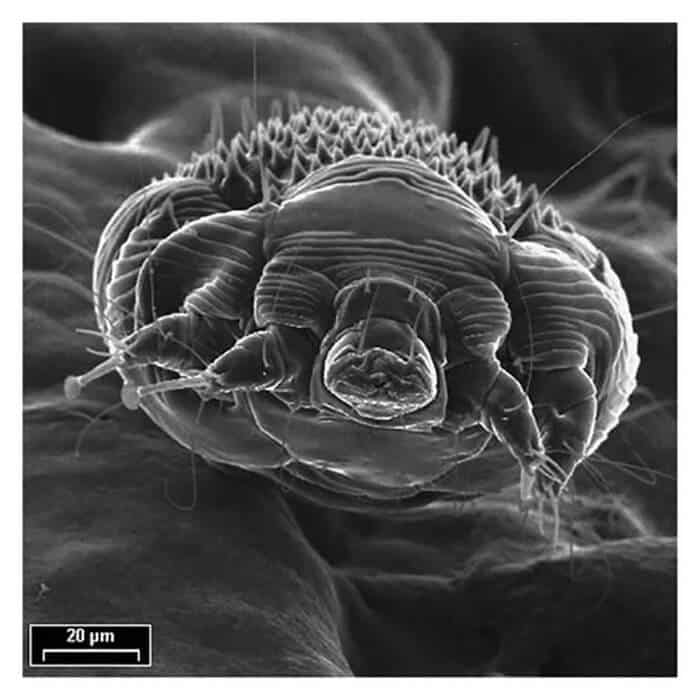
- Females lay 40-50 eggs, within 3 – 7 days the eggs will hatch into larvae.>
- The larvae scabies are almost like an adult one but they only have 3 feet. After hatching, the larvae puncture the groove to move outside.>
- After a little while, the larvae transform into a nymph with 4 feet; two forelegs are clingy, hind legs have silk as mature form. But there is no genital hole.>
- After a while, the nymphs develop into adult scabies. Under the right conditions, scabies needs 15 – 20 days to complete their life cycle.>
- From initial scabies, within 3 months, they can produce a population of up to 150000 individuals.>
- Scabies in dogs is directly transmitted through contact, through livestock tools, clothes of the caregiver.>
- The disease develops in autumn-winter; less in summer because sunlight wipes out scabies.>
Read more >>> Eczema In Dogs: Symptoms, Causes, & Treatments
Symptoms of Scabies in Dogs
- Symptoms of scabies in dogs progressed in 3 consecutive periods: into pore spots, large plaques, and then spread to the whole body.
- Scabies appears in thin skin area such as the abdomen, armpits, groin, ear base, around the breast. Symptoms of scabies include itching, hair loss, and scaling.
- Itching caused by burrowing scabies and by the toxicity in the saliva of scabies stimulates atopic dermatitis. The sick dog scratches with his feet and bites the itchy area with his teeth or rubs frantically on anything.
- Capsulitis develops causing the losing hair.
- The hair falls in round patches, at first only 2-3 mm in each direction. Then it spreads around because female scabies lay a lot of eggs. Adult scabies does not gather in one place but goes all over the body, causing hair loss to spread.
- In the itchy areas, blisters as big as pin-tips will be formed. This pimple forms by scabies’ saliva.
- When the dog scratches, the fluid drips with blood, and the fragments of the epidermis are sloughed off into a pale brown scab. In areas with hair loss, this scab can be up to 3 – 4mm thick.
- The hair loss area continues to increase, spread. Dog’s skin becomes thicker and wrinkled, has a very unpleasant stench.
- Lesions of scabies is a serious inflammation of the skin of various areas, possibly all the skin. The groove in the skin has scabies, their eggs are at different stages of progression and the feces are black seeds.
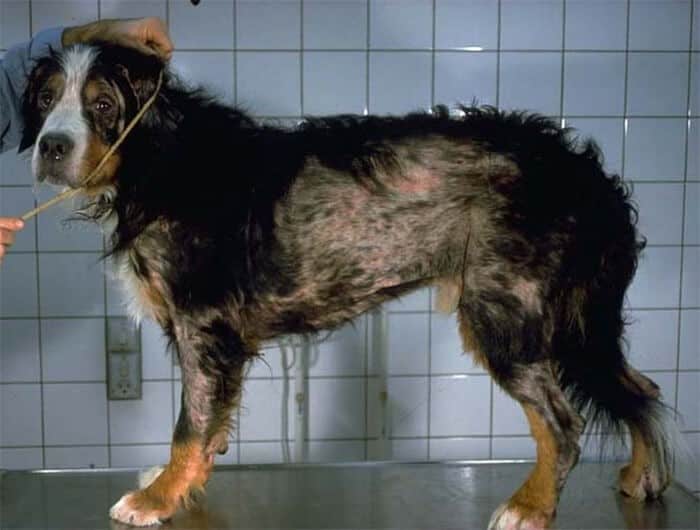
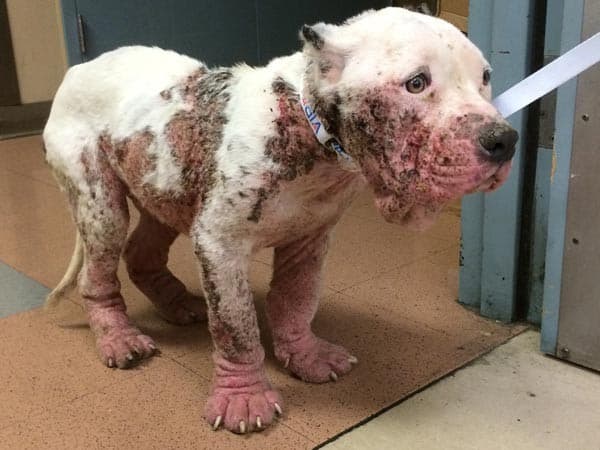
Diagnose
- Based on the epidemiological characteristics of clinical manifestations to diagnose animals with suspected scabies.
- Next, shaving the area skin which is suspected of having scabies to make a final conclusion.
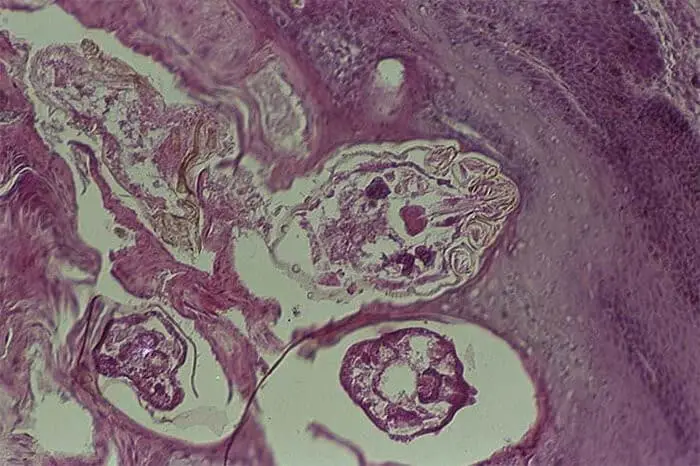
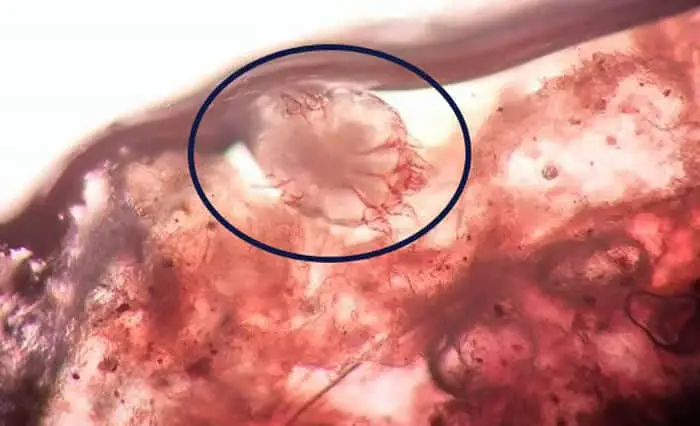
Read more >>> Rabies in Dogs and Cats – Diagnose and Treatment
Prevention
- Regularly clean the dog’s body, it is best to bathe the dog with specialized pet bath lotions or use sorbet water, acrid leaf water, bitter leaves such as peach, guava, oval, nacre leaves ….
- To detoxify the dogs’ dwellings and barns with antiseptic solutions: chloramine B 0.5%, lime water 10%.
- After spraying, disinfect the barn, the bedding of other nourishing tools should be dried in the sun.
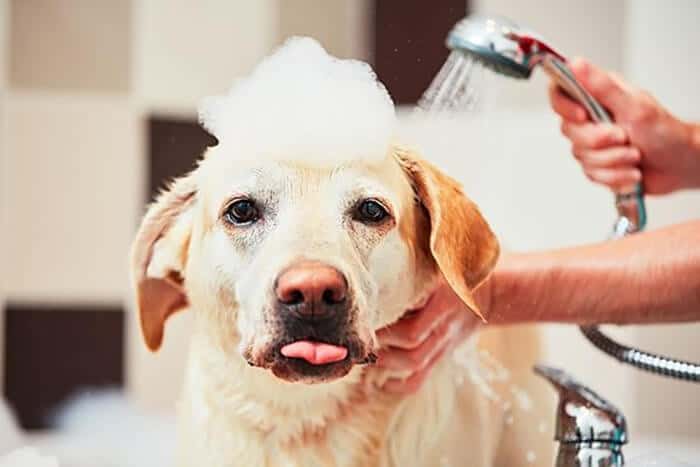
Treatment of scabies in dogs
- Use soothing lotions to treat scabies
- Before applying the lotion, shaving the hair in the infected area, shaving the pimples, and bathing the dog. You should use specialized shower gel for dogs and cats.
- Bathe with kinds of acrid leaves water: peach leaves, oval leaves, nacre leaves,….
- Use one of the following lotion creams to apply on the scabies area: DEP (Diethyl phthalate), Extopa, Trinaghe, Tribeloda, amitraz 0.025%. Apply into hair loss area and around, 2-3 times a day, for several days.
- Inject with a special medicine for scabies
- Ivermectin 0.2mg / kg based on body weight.
- Doramectin (Dectomax) produced by Pfizer, a dose of 1ml / 10kg base on body weight.
- Hanmectin produced by Hanvet, dose 1ml / 10kg bodyweight.
- Injectable drugs should be used once a week; 4-5 times. Every time you inject drugs, you must clean and disinfect the dog area.
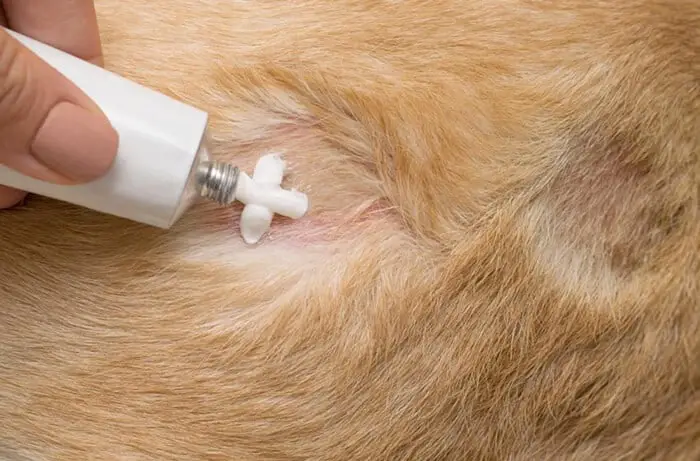
Anti-inflammatory and anti-infection drugs
- Because scabies causes atopic dermatitis and may lead to infection. Depending on the severity of the disease, the different anti-inflammatory and anti-infectious drugs are required.
- Intramuscular injection of Dexamethasone 0.1%. Apply lotions: Hydrococtizon, Dexamethasone, Flucinar,….
- Use antibiotics, vitamins, non-specific stimulants to increase resistance to the disease when there is a marked infection.
Read more >>> Calcium Deficiency Seizure in Dogs and Cats ( Before and after giving childbirth)
Some things to note when treating scabies in dogs
- You should put the dog head into the noose before applying the medicine to prevent the dog from licking the medicine.
- Do not bathe your dog with allergy soap. Scrub it with a towel or brush to remove all the scales from the skin, then dry it before applying the medication.
- Instruments for caring and nurturing dogs must be disinfected with antiseptics and exposed in the sun.
- Scabies in dogs should be treated for a long time, treated in several courses, each course lasts for 5-7 days.
In the case of systemic scabies, you should not apply the whole body at once. Instead, divide the body into parts and apply the drug at different times, to avoid poisoning the dog.
- You must isolate the sick dog in a separate area, have separate care and nurturing regime and apply a comprehensive treatment regimen (using medicine to treat scabies in combination with using antibiotics to treat symptoms and strengthen the dog’s body’s resistance.
Can dog scabies transmit to people?
As discussed above, scabies in dogs is caused by female scabies. When humans come into contact with an infected animal, a small amount of scabies can spread to human’s body, but it is not enough to cause scabies disease.
Because humans are less hairy and regularly bathe, so dog scabies is not contagious to humans!
However, those who have sensitive skin when contact with infected pets, they can have signs of allergy such as rashes, skin pimples. Therefore, farmers need to clean their hands immediately after contact with their pets. Pregnant women and young children should stay away from infected pets.
Above is the sharing from experts of Vetguru, we hope that it helps you gain more experience in taking care of pets, effectively preventing scabies in dogs.

1 thought on “How to Treat the Sarcoptes Scabies in Dog (Sarcoptes Scabiei var Canis)”